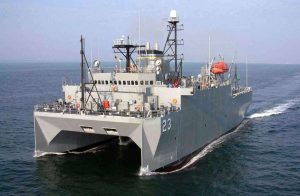A U.S. shipyard is proceeding with initial studies and design evaluation for a new generation of advanced ocean surveillance vessels for detecting and tracking submarines, with the first ship to be delivered in 2025. The yard also built the U.S. Navy’s last ocean surveillance ship, the USNS Impeccable, which was threatened and harassed by Chinese planes, ships, and paramilitary militia vessels in a high-profile South China Sea incident 2009.
The existing unarmed research vessels make an outsized contribution to the U.S. Navy’s anti-submarine capabilities. By trailing sensitive listening equipment on miles-long cables behind them called the Surface Towed Array Sensor System (SURTASS), the vessels are able to detect and then help track submarines from great distances, and then provide that data to other ships, planes, or submarines. Their unusual catamaran design provides stability in rough seas and reduces the sound transmitted into the water by the ship’s machinery.
The U.S. Navy’s small fleet of five ocean surveillance ships will begin to reach the end of their service lives in 2025, when the first of the new generation is expected to be delivered. The Navy may ultimately buy six or seven of the new vessels, underscoring their importance to maintaining the United State’s undersea edge in the Western Pacific. Former Pacific Command chief Admiral Harry Harris described the U.S. Navy’s undersea superiority as its most important asymmetric military advantage over China in the region.
Earlier this year China deployed two additional Type 094 ballistic missile submarines, bringing its fleet of nuclear deterrent submarines to six. Sea-based nuclear deterrents are generally considered to be the most secure, compared to land-based missiles or bombs delivered by aircraft, which might be more easily targeted.
China is designing an advanced new nuclear-tipped ballistic missile believed to be for its next-generation ballistic missile submarines, the Type 096, which are under development. The new JL-3 missile may have a range of 12,000 kilometers, which would enable to target most of the United States from off China’s coast. South China Morning Post reports that the new Type 096 submarine armed with JL-3 missiles might be ready by 2025, the same year that the U.S. Navy’s new surveillance ships are expected to begin to be delivered.
Recognizing the advantages that advanced undersea detection capabilities provide, China has been working to develop its own fleet of ocean surveillance vessels in recent years. China may now have at least three such surveillance vessels.
Concerned by China’s growing assertiveness and potential threat, Japan has also sought to improve its undersea surveillance capabilities. As recently as June 2020, Japan detected a likely Chinese submarine in its contiguous waters around the Ryukyu Islands. In 2018 a Chinese submarine ignored repeated warnings while sailing in the vicinity of the Japanese-administered Senkaku Islands, which China claims as its own and calls the Diaoyu Islands.
In response to these and similar incidents, in March Japan launched its first new ocean surveillance ship in almost 30 years in a sign of its concern over China’s growing submarine fleet. Japan now has a fleet of three advanced sub-tracking ships. The Japanese vessels also carry SURTASS, making Japan’s the only foreign navy equipped with the sensitive U.S.-built technology.

































